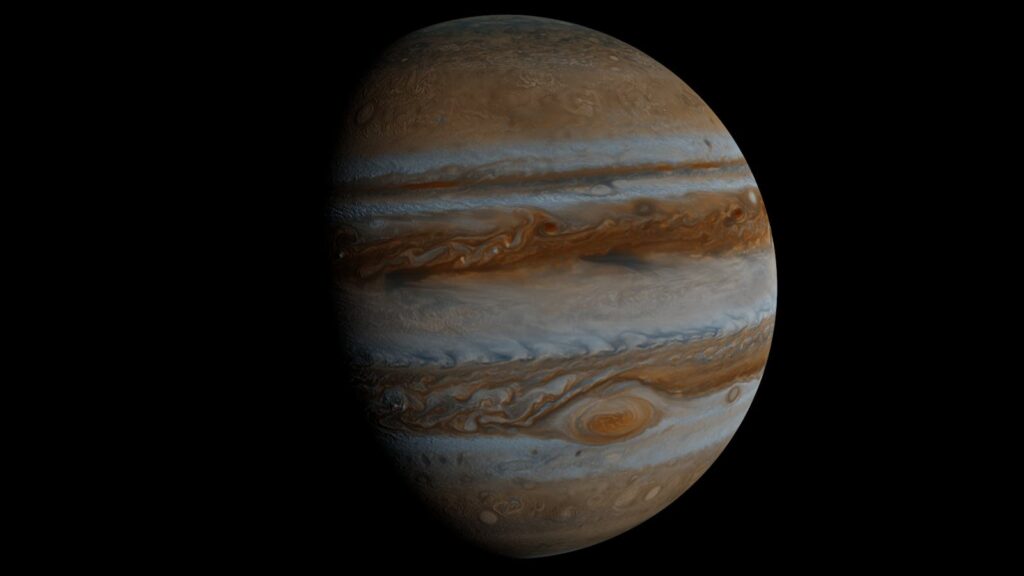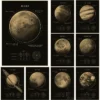Jupiter’s Great Red Spot: The Solar System’s Most Mysterious Storm
High above the churning clouds of Jupiter, a colossal tempest rages on, captivating astronomers and stargazers for centuries. This is the Great Red Spot, a massive hurricane-like storm that has been swirling in the planet’s atmosphere for over 300 years. At a staggering 10,000 miles wide, this crimson-hued vortex is large enough to swallow Earth whole. It has become one of the most recognizable features of our solar system’s largest planet.
For as long as humans have been observing Jupiter through telescopes, the Great Red Spot has remained a constant presence. It’s an enigmatic eye staring back at us from across the vast expanse of space. Yet despite centuries of study, this extraterrestrial marvel continues to hold many secrets. From its exact age and origin to the source of its distinct reddish hue.
A Storm Like No Other
At first glance, the Great Red Spot might seem similar to the hurricanes that form on Earth. However, a closer look reveals just how different this Jovian tempest truly is. Our terrestrial hurricanes are born from a complex interplay of warm ocean waters, atmospheric conditions, and the rotation of the Earth itself. They are fueled by the evaporation of seawater and the release of latent heat. This allows them to grow and intensify as they travel across the ocean.
The Great Red Spot, on the other hand, is a completely different beast. This storm is not driven by ocean currents or seasonal changes but instead appears to be self-sustaining. It seems to be drawing its energy from the immense heat radiating up from Jupiter’s interior. With no solid surface to disrupt its flow and a virtually unlimited supply of atmospheric gases to feed on, the Great Red Spot has been able to maintain its strength and size for centuries, outlasting even the most powerful hurricanes on Earth.
The Color Conundrum
One of the most striking features of the Great Red Spot is its vivid coloration, which has long puzzled scientists. While the storm has been described as “red” since its discovery. Its actual hue can vary from a deep crimson to a pale salmon pink. At times it has even appeared to be more of a creamy white.
So what gives the Great Red Spot its distinctive color? The prevailing theory among astronomers is that the reddish tint is caused by the presence of complex organic compounds called hydrocarbons. These are formed when solar radiation breaks down the trace amounts of methane and ammonia in Jupiter’s atmosphere. These hydrocarbons, which can include chemicals like acetylene, are thought to absorb blue and green light while reflecting red light. This gives the storm its characteristic hue.
However, the exact chemical composition of the Great Red Spot remains a mystery. As does the precise mechanism by which these compounds are produced and maintained within the storm’s swirling vortex. Some scientists have suggested that the storm’s color may also be influenced by the presence of other atmospheric constituents. These could include sulfur or phosphorus. While others have proposed that the reddish tint could be the result of complex interactions between the storm’s internal dynamics and the surrounding atmospheric flows.

A Storm in Decline?
As if the Great Red Spot’s origins and coloration weren’t enigmatic enough, astronomers have also been grappling with another perplexing development in recent years: the storm appears to be shrinking. Historical observations suggest that the Great Red Spot was once much larger than it is today. It is estimated that it possibly spanned more than 30,000 miles across in the late 19th century. However, over the past few decades, the storm has been steadily decreasing in size. It now measures a “mere” 10,000 miles in diameter.
The reasons for the Great Red Spot’s apparent decline are not entirely clear. Some scientists have speculated that it could be related to changes in Jupiter’s atmospheric circulation patterns. Some argue it is due to the gradual dissipation of the storm’s energy over time. Others have suggested that the shrinking of the Great Red Spot could be part of a natural cycle. The storm may be periodically growing and contracting over the course of decades or centuries.
Regardless of the cause, the prospect of losing the Great Red Spot altogether is a sobering one for astronomers and space enthusiasts alike. This storm has been a constant companion in our exploration of the solar system. It’s a reminder of the raw power and beauty that exists beyond our own small planet. To imagine a Jupiter without its iconic red eye is to contemplate the end of an era. The loss of a celestial wonder that has captured our imaginations for generations.
Unraveling the Mysteries
Despite the many questions that still surround the Great Red Spot, scientists are making progress in unraveling its secrets. In recent years, NASA’s Juno spacecraft has been orbiting Jupiter, providing unprecedented views of the planet’s atmosphere and giving researchers new insights into the workings of its famous storm.
With each pass over the Great Red Spot, Juno’s instruments have revealed new details about its structure and composition, from the swirling eddies that encircle its edges to the towering clouds that rise up from its center. By studying the storm’s internal dynamics and its interactions with the surrounding atmosphere, scientists hope to gain a better understanding of how such a massive and long-lived tempest can form and persist on a gas giant planet like Jupiter.
But even as we continue to probe the mysteries of the Great Red Spot, we are reminded that there is still so much we don’t know about the wonders of our cosmic backyard. From the icy geysers of Enceladus to the methane lakes of Titan, the solar system is full of marvels that defy our earthly intuitions and challenge our understanding of what is possible in the universe.
And so, as we gaze up at the night sky and ponder the fate of Jupiter’s Great Red Spot, we are humbled by the vastness and complexity of the cosmos that surrounds us. We are reminded that even the most enduring and familiar of celestial objects can hold surprises and secrets that we have yet to uncover. And we are inspired to keep exploring, to keep pushing the boundaries of our knowledge and our imagination, in the hopes of one day unraveling the greatest mysteries of the universe we call home.



